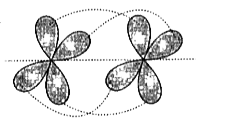Which of the following gives rise to the formation of bond ?




The correct Answer is:B
To determine which of the options gives rise to the formation of a bond, we need to analyze the interactions between the orbitals based on their signs (phases). Here's a step-by-step solution:
Step 1: Understand Orbital Overlap
- Bonds are formed when atomic orbitals overlap. The nature of this overlap (whether it is constructive or destructive) determines if a bond or an anti-bond is formed.
Hint: Remember that constructive interference leads to bonding, while destructive interference leads to anti-bonding.
Step 2: Identify the Signs of the Orbitals
- Orbitals can have positive (plus) or negative (minus) signs.
- When two orbitals with the same sign overlap, they create a bonding orbital.
- When two orbitals with opposite signs overlap, they create an anti-bonding orbital.
Hint: Look for the signs of the orbitals in each option to determine the type of bond formed.
Step 3: Analyze Each Option
1. Option 1: Plus and Plus
- Overlap leads to bonding (constructive interference).
- Conclusion: This option forms a bond.
2. Option 2: Plus and Plus
- Overlap leads to bonding (constructive interference).
- Conclusion: This option forms a bond.
3. Option 3: Minus and Plus
- Overlap leads to anti-bonding (destructive interference).
- Conclusion: This option does not form a bond.
4. Option 4: Minus and Plus
- Overlap leads to anti-bonding (destructive interference).
- Conclusion: This option does not form a bond.
Hint: Compare the signs in each option to determine if they will lead to bonding or anti-bonding.
Step 4: Determine the Correct Option
- From the analysis, we see that the second option (Plus and Plus) is the only one that consistently leads to the formation of a bond.
Final Conclusion: The correct option that gives rise to the formation of a bond is Option 2.
- Bonds are formed when atomic orbitals overlap. The nature of this overlap (whether it is constructive or destructive) determines if a bond or an anti-bond is formed.
- Orbitals can have positive (plus) or negative (minus) signs.
- When two orbitals with the same sign overlap, they create a bonding orbital.
- When two orbitals with opposite signs overlap, they create an anti-bonding orbital.
1. Option 1: Plus and Plus
- Overlap leads to bonding (constructive interference).
- Conclusion: This option forms a bond.
- Overlap leads to bonding (constructive interference).
- Conclusion: This option forms a bond.
- Overlap leads to anti-bonding (destructive interference).
- Conclusion: This option does not form a bond.
- Overlap leads to anti-bonding (destructive interference).
- Conclusion: This option does not form a bond.
- From the analysis, we see that the second option (Plus and Plus) is the only one that consistently leads to the formation of a bond.
Topper's Solved these Questions
Similar Questions
Knowledge Check
Which of the following is required for the formation of an ionic bond ? .
AAn electron from the more electronegative element should be transferred to the less electronegative .BThe total energey of the resulting molecule should be less than the total energy of the reactants .CThe lattice energy of the resultants molecule should be as low as possible .DThe ionic potential of the reactants should be identical .Which of the following diagrams indicate the formation of bonds?
A B
B C
C D
D
Which of the following is/are correact for the formation of π bond ?
Aoverlapping of px−px(Z internuclear axis)Boverlapping of pz−pz orbitals(Z internuclear axis)Coverlapping of py−py orbitals(Z internuclear axis)Doverlapping of s−pz orbitals (Z internuclear axis)
Which of the following would result in the formation of strongest π- bond if the molecular axis is X-axis?
View SolutionWhich one of the following gives imine formation with carbonyl compounds
View SolutionWhich of the following condition favours the bond formation?
View SolutionHeat of which of the following reaction gives enthalpy of formation directly?
View SolutionWhich of the following gives correct arrangement of compounds involved based on their bond strength?
View Solution
